Classification of Minerals (1. Native element, 2. Sulfides)
According to the dominant anion or anion group, minerals are generally classified as follows: 1) Native elements, 2) Sulfides, 3) Halides, 4) Oxides and Hydroxides, 5) Carbonates, Nitrates, Borates, 6) Sulfates, Chromates, Tungstates, Molybdates, 7) Phosphates, Arsenates, Vanadates, and 8) Silicates.
1. Native Elements
About 20 native elements are found in nature, among which gold, silver, copper, diamond, graphite and sulfur are abundant. Native elements can be subdivided into metals, semimetals and nonmetals. Metals include gold, silver, copper, platinum and iron. Semimetals are arsenic, antimony and bismuth and nonmetals are sulfur, diamond and graphite.
Gold group metals like gold, silver and copper tend to be soft, malleable, ductile and sectile. They are characterized by high density, metallic luster, poorly defined crystal form and low melting points, and are good conductors of heat and electricity. Native semimetals are brittle and much poorer conductors of heat and electricity than the native metals. Polymorphic nonmetals, diamond and graphite, are quite different from each other in their properties. Graphite shows relatively high electrical conductivity, while diamond is one of the best electrical insulators. Graphite is characterized by softness with Mohs hardness of 1-2. Diamond is the hardest mineral in nature. Graphite is black and opaque. Diamond is colorless or pale yellow and transparent. Sulfur is yellow, brittle and a poor conductor of heat.

Diamond in Kimberlite South Africa
More than 50 % of diamonds are mined from the rock ‘kimberlite’. The remainder are mined from placer deposits.
Diamond is the hardest mineral in nature with Mohs hardness of 10.
2. Sulfides
The sulfides, a mineral class in which sulfur is combined with metals or semimetals, occupy about 0.15% of the earth's crust. They are economically important because many useful metals are acquired from them. Arsenides, selenides, tellurides, and antimonides can be included in sulfides because of their similarities in structural, chemical and physical properties.
Some sulfide minerals such as realgar, orpiment or cinnabar transmit light at thin edges, but most sulfides show opaque, metallic luster. They are also characterized by low hardness, high sectility and black to dark gray streak color. They are generally of igneous origin.
The general formula for the sulfides can be expressed in XmZn, where X indicates the metallic elements and Z the nonmetallic elements. For instance, pyrite (FeS2), galena (PbS), chalcocite (Cu2S), sphalerite (ZnS), millerite (NiS), arsenopyrite (FeAsS) and boulangerite (Pb5Sb4S11) are sulfide minerals.

CylindriteBolivia
As the name implies, cylindrite is characterized by cylinder-like crystal form. Its Mohs hardness is relatively low, about 2.5.

Sulfur Bolivia
Sulfur is characterized by its yellow color and easy ignition. It is used for the manufacture of sulfuric compounds, insecticides, artificial fertilizers, soaps, paints and textiles.

Native Copper Michigan, USA
Native copper is an uncombined form of copper which occurs as a natural mineral. Copper is one of the few metallic elements to occur in native form, although it most commonly occurs in oxidized states and mixed with other elements. Native copper was an important ore of copper in historic times and was used by pre-historic peoples. Native copper is ductile, malleable, sectile, hackly and opaque. It has a reddish, orangish, and/or brownish color on fresh surfaces.
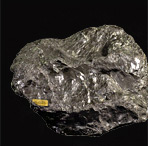
Graphite Mungyeong, Korea
Graphite is black, soft, greasy and infusible. Graphite and diamond are carbon polymorphs. It has a high melting point, more than 2,000℃. It is used in foundry facings, crucibles, electrodes and lubricants.
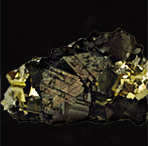
Sphalerite Peru
Sphalerite is a main ore mineral of zinc. It shows adamantine or resinous luster.
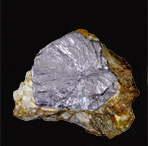
Molybdenite Chungju, Korea
Molybdenite is a main ore mineral of molybdenum. It has low hardness between 1.5 and 2.
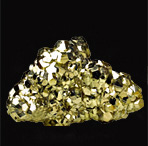
Pyrite Peru
Pyrite is called 'fool's gold' because it is sometimes mistaken for gold. It is used for the manufacture of sulfuric acid.
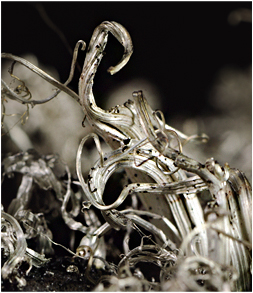
Native Silver Morocco
Native Elements: Ag
Native silver occurs as elongated dendritic coatings or irregular masses. It may also occur as cubic, octahedral, or dodecahedral crystals. It may occur alloyed with gold as electrum. It often occurs with silver sulfide and sulfosalt minerals.
Native silver is highly ductile and malleable and shows metallic luster. Hardness ranges from 2.5 to 3 and specific gravity is about 10.5. Silver color is typical, may change to brown or grayish black. Native silver is a not only popular jewel, but also used in plating, development of films, and making tablewares and manufacturing electronic equipments.

Tetrahedrite Peru
Sulfide: Cu12Sb4S13
Tetrahedrite, named after its tetrahedral habit, is one of the most widespread and economically important sulfosalt minerals for copper and silver. Commonly twinned, it is opaque and black with metallic luster. It dissolves in nitric acid and forms a complete solid solution series with tennantite (Cu12AS4S13).